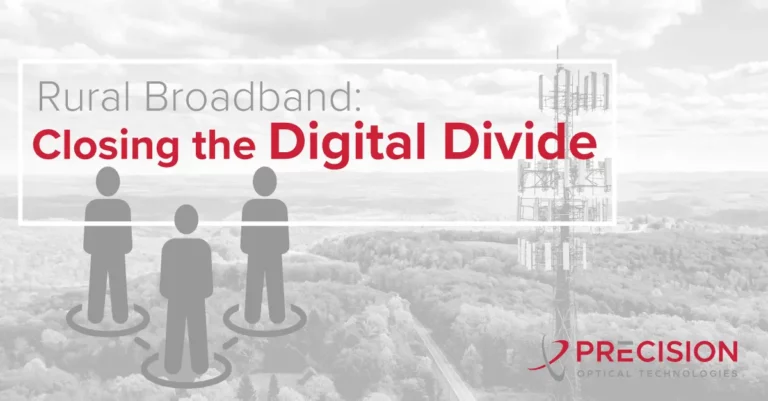
Bringing the New Deal of Rural Broadband to Life

It’s time to end the digital divide for rural broadband.
Around the world, governments are focusing on this as a top priority. In the US, the Federal Communications Commission (FCC) is continuing to release funding to winners of the Rural Digital Opportunity Fund (RDOF) Phase 1 auction. President Biden has also unveiled the American Jobs Plan, which includes $65 billion over 8 years to close gaps in the country’s digital infrastructure. In Europe, public and private entities are also investing money into better broadband coverage for rural and underserved areas.
So, why the rush of investments? What are the benefits of bringing better broadband to rural communities? Most importantly, what are the challenges today’s carriers, MSOs and other network operators face as they deliver on their planned rural broadband build outs? Let’s explain.
The Worldwide Focus on Closing the Digital Divide
According to the OECD, the term “digital divide” refers to the gap between those with ready access to information and communication technologies (ICTs), including the internet, and those without. Here in the US, efforts to close the digital divide have tended to concentrate on internet access and speeds.
Over the past year, the FCC has embarked on an ambitious plan (RDOF) to invest over $20 billion over 10 years to finance “up to gigabit speed broadband networks in unserved rural areas, connecting millions of American homes and businesses to digital opportunity.” According to the FCC, the minimum acceptable speed for service providers to deliver is 25 Mb/s down and 3 Mb/s up. Total support for the winners of the RDOF Phase 1 auction is now well over $475 million. In July, 2021, the FCC announced $311 million for 48 service providers. The latest batch of funding adds $163.9 million into the pot for network build outs to over 65,000 locations across 21 states.
In Europe, the situation is similar. Italy, for example, is aiming at spending 6.7 billion euros from the European Union (EU) on broadband infrastructure as it works to deliver on a national plan to improve digital competitiveness for the entire country. The UK government also has a plan to deliver access to gigabit broadband to 85% of UK properties, including those in rural areas, by 2025. Known as Project Gigabit, the plan provides financial incentives to carriers and other fiber providers to design and implement these networks. All across the EU, in fact, government and the private sector are working together to roll out greenfield Fiber-to-the-Home (FTTH) networks.
All of that is good news. Broadband is a lifeline to rural areas, enabling those citizens to enjoy access to essential services around healthcare, education and employment. Fiber also gives businesses the speed, low latency and reliability needed to expand in rural regions. Previously seen as uneconomical, government incentives are now making it worthwhile for network operators to bring fiber-based broadband to rural areas. But it’s not a simple task by any stretch of the imagination. From design to implementation, it’s a complicated task – but with the right expertise and partners, completely doable and cost effective.
Challenges of Deploying Broadband in Rural Areas
When it comes to planned rural broadband build outs, network operators are mainly turning to two types of networks architectures – FTTH and Metro Ethernet.
Fiber to the Home – FTTH
When it comes to FTTH, network operators have a choice in deployment architectures: Fiber to the Premise/Home/Business; Fiber to the Building and Fiber to the Cabinet/Curb. We talk about these in detail in this blog here.
The main challenge of FTTH deployments is the high cost of installing fiber infrastructure in the area the provider wishes to serve. Accomplishing this requires multiple technical decisions about the type of networking technology to use, optical networking equipment to purchase and how to keep the speed of deployment up as much as possible, especially with permitting and construction timelines.
When it comes to FTTH Passive Optical Network (PON) technology, GPON and XGS-PON stand out as two key standards for the access part of the network. Whereas GPON enables asymmetrical downstream and upstream rates of 2.5 Gb/s and 1 Gb/s respectively, XGS-PON provides symmetrical rates of 10Gb/s. This makes XGS-PON an optimal solution for supporting businesses and multiple dwelling units (MDUs) in addition to residential services. Because it is capable of enabling higher bandwidths, XGS-PON technology in greenfield FTTH deployments results in demand for 100G links between the points of presence (POPs) upstream in the network. The trick to implementing new and powerful technologies in a cost-effective manner, especially in traditionally uneconomical rural areas, is in finding a partner that is not only a vendor but also a specialist in network design.
At Precision OT, we play a pivotal role in improving FTTH deployment speeds, quality, and costs. We offer the widest variety of cost-effective, NEM-compatible optical transceivers that have undergone rigorous diagnostic testing and are backed by a lifetime warranty. Whether you’re looking for short range FTTH-compatible 1G SFP (SR) optics, which are frequently used to build out enterprise connectivity to the end-user infrastructure, or custom programmed back haul CWDM/DWDM solutions that enable traffic from multiple OLTs to be transported to a common aggregation point, we have you covered.
Metro Ethernet
As noted earlier, Metro Ethernet is another method of providing reliable, scalable and cost-effective connectivity for residential and business applications. Used for point-to-point and multipoint services over a metropolitan area network (MAN), Metro Ethernet is gaining traction in rural network designs through the use of high density DWDM transport. Whether interconnecting businesses, connecting residential end-users or employees to the internet, or linking businesses to public or private clouds, Metro Ethernet offers service providers wide-scale, interoperable connectivity from the network edge to the core.
In the modern era of rural build outs and a need to support bandwidth-intensive recreational, educational and business applications, service providers require an even greater boost in capabilities.
Bringing it Full Circle
With any kind of greenfield network deployment, issues around network design, equipment selection and cost abound. A network equipment manufacturer that also offers incredible expertise in all things related to optical networking is an invaluable asset. That’s what our team has to offer you. We pride ourselves on the interoperability of our components, it’s true. On an even deeper level, however, we offer knowledge. We can assess network design and requirements to develop truly customized solutions at scale that will help you bring the different parts of your network together as you wish. We test and refine our solutions in our world-class laboratory and we stand with you through design, implementation and management. As you look to deliver a network that will revitalize remote communities, we can help you turn your complex goals into reality. Contact us to learn more.






